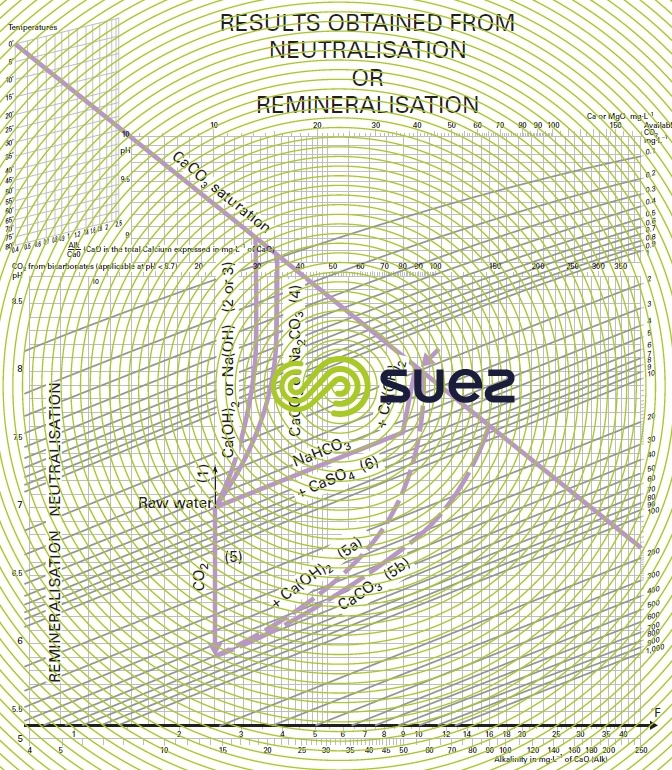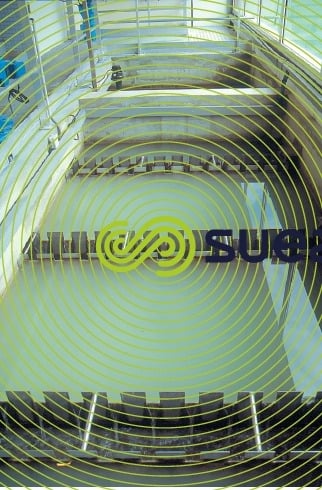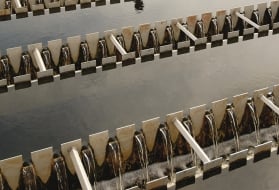reagent and treatments than can be used
Reading time:neutralisation or soft water remineralisation
We use the term neutralisation when the CO2 used to produce bicarbonates is supplied by the raw water.
We use the term remineralisation when we add CO2 (or possibly HCO3 ions).
Figure 108 shows the changes undergone by water depending on the different equilibrium reinstatement processes, i.e :
- CO2 stripping (a process usually restricted to 5-7 mg · L–1 of residual CO2) ;
- neutralisation using lime: Ca(OH)2 + 2CO2 → Ca(HCO3)2;
- neutralisation using sodium hydroxide: NaOH + CO2 → NaHCO3;



Figure 108. Various equilibrium reinstatement processes - neutralisation using carbonates :
- calcium carbonate: CaCO3 + CO2 + H2O → Ca(HCO3)2,
- sodium carbonate: Na2CO3 + CO2 + H2O → 2NaHCO3;
- remineralisation using CO2 + lime (5a) or CO2 + calcium carbonate (5b), according to the same reactions as applicable in processes (2) and (4a) ;
- remineralisation by injecting sodium bicarbonate and a calcium salt (or bicarbonate on its own if there is an adequate TCa level).
Comments :
- Methods 3, 4b and 6 involving sodium ions must be banned as part of a basic treatment because sodium ions cannot contribute to the formation of the Tillmans film.
- Additionally, method 6 contributes to an increased level of unwanted ions (Cℓ– or SO42–) and must only be considered for very slight increases in M-alk, also taking changes to the Larson index into account.
- In fact, only processes 1, 2, 4a and 5 can be recommended and used industrially.
- Method 3 can be used to supplement processes 1, 5a, 5b or 6 in order to achieve a precise adjustment of pH but using low amounts (in France, the Superior Council for Public Health recommends a ΔNa ≤ 5 mg · L–1).
for neutralising hard water
acidification
Hard water has a natural tendency to precipitate its excess bicarbonates by shifting the balance (1) to the right; consequently, its figurative point will be fairly close to the equilibrium and, therefore, scale-forming water rarely requires correcting: should it do so, all that will be required is an injection of acid to release the CO2 required.
CO2 can also be injected direct.
carbonate removal
It has been seen that the equilibrium pH in excessively hard water is so low that it does not allow lead carbonate to form and that it becomes impossible to guarantee the thresholds set by the Standard (Pb < 10 μg·L–1) when the system comprises lead pipes or accessories … Furthermore, as soon as this water heats up, it becomes very scale-forming (see washing machines, water heaters …).
Therefore, in these cases, we recommend a carbonate removal step. The relevant reactions have been described in the section chemical precipitations. Reminder: the reagents that can be used are lime and sodium hydroxide and, when the water contains sufficient "permanent" hardness (linked to chlorides or sulphates), sodium carbonate. Compared with lime, sodium hydroxide removes more calcium than bicarbonates but the water becomes sodium-enriched: this is "softening"; on the other hand, if we refer to CaH fluctuations, we produce half the precipitate but M-alk is not reduced as much.
Consequently, before selecting the treatment reagent, we need to check that the water obtained will not become corrosive.



Please refer to the section changes to the carbonate balance, for a description of the processes and machines used by SUEZ to carry out these remineralisation and equilibrium reinstatement treatments.
Bookmark tool
Click on the bookmark tool, highlight the last read paragraph to continue your reading later













